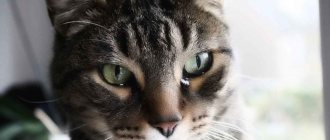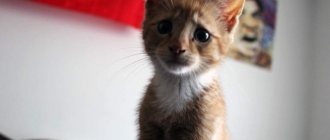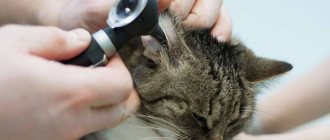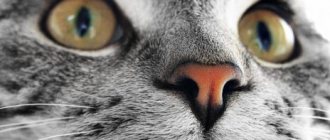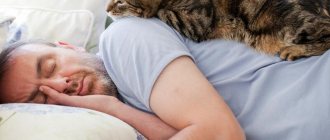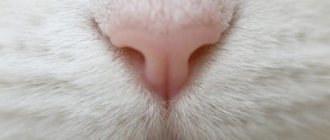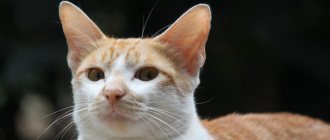When tachypnea is a variant of the physiological norm
The natural respiratory rate in cats ranges from 20 to 40 dd/min . Much depends on the size of the animal (its weight), age and gender. There are many reasons why a cat breathes quickly, but this is not a pathology. In addition, we cannot exclude the fact that cats are stress-unresistant animals that fall into a state of stress and emotional distress with or without cause, and this state is not asymptomatic.
Most often, breathing quickens against the background of:
- joy, rage or fear;
- hormonal changes (during or after childbirth, bearing kittens, estrus);
- stress when transporting or moving from home to any unfamiliar place;
- worries and fear when visiting a veterinarian, unpleasant manipulations in a veterinary clinic, after taking or injecting certain medications;
- conditioned fatigue after eating;
- overheating in the hot season or in a stuffy room.
The indicated list of causes of rapid, shallow breathing does not pose a threat to the health and life of the cat and is considered physiologically compensated. This means that after the cessation of the influence of the underlying causes, the frequency and depth of breathing returns to normal.
When to pay attention to rapid breathing
If the cat began to breathe quickly and shallowly unexpectedly, and none of the above list of reasons preceded this, a pathological condition should be excluded. The more sudden the tachypnea appears, the sooner Murka should be taken to the veterinarian.
An increase in the number does not always accompany pathologies of the respiratory system. This clinical sign may also occur in other systemic diseases as a secondary symptom. That is, rapid breathing has pulmonary and extrapulmonary causes.
We recommend reading: Features of breeding quails at home: feeding and care
Pathologies of the respiratory system
- problems in the nasal cavity and nasal passages (infections, narrowing, neoplasms, inflammatory processes);
- pathologies in the bronchi (bronchitis, asthma, lung worms);
- diseases of the trachea and larynx (collapse, neoplasms);
- swelling in the chest cavity;
- pulmonary pathologies (edema, inflammatory processes, helminths, tumors, lobe overlap);
- pneumothorax (air in the chest cavity due to injury);
- diaphragmatic hernia;
- neoplasms in the breast, accompanied by enlarged lymph nodes.
Pathologies accompanied by rapid breathing in a cat, but not related to the lungs:
- heart failure, disturbances in heart rhythm (arrhythmias, tachycardia and bradycardia);
- poisoning;
- neurological pathologies (skeletal and spinal injuries, pinched nerves, inflammation of nerves);
- endocrine pathologies (hyperparathyroidism);
- shock of any form;
- oncology, especially in the last stages;
- dehydration and febrile conditions accompanied by high temperature;
- overheating, heat stroke;
- postoperative period, recovery time from anesthesia, pain.
Treatment methods
Viral respiratory tract infections in cats are treated with antibiotics, immunomodulators, antiviral and anti-inflammatory drugs, and vitamins. Therapy is aimed at relieving the symptoms of the disease and preventing complications.
If a cat is diagnosed with trauma or cancer, surgical intervention is most often used. About half of the time a foreign body in the airway causes a foreign body to see a doctor, surgery is also required. Sometimes a cat's difficulty breathing, which is associated with a malignant tumor, is restored with the help of chemical or radiation therapy. In other cases, the doctor prescribes medication.
It happens that a cat breathes heavily with his mouth open and does not eat after undergoing surgery. This condition is part of the body's recovery process from the effects of medications.
Not all cats tolerate narcotic anesthesia easily. If it is determined that the cause of the cat's breathing jerks is pain or intoxication after anesthesia, the doctor gives the animal an anesthetic and prescribes a course of treatment. After some time, the animal’s breathing is restored.
How to help a cat during an attack of tachypnea
The first thing is that there is no need to panic. The owner’s task is to determine whether this condition is physiological or not in order to seek help from a specialist in time.
Remember: if shortness of breath is accompanied by:
- lethargy;
- any temperature fluctuations, either up or down;
- meowing in pain;
- heart rhythm disturbance;
- vomiting, diarrhea;
- violation of movement coordination.
then this is a clear reason to visit the veterinarian! The essence of the danger of breathing fluctuations lies in a change in the composition of the blood, which under certain conditions can lead to the death of the cat if a diagnosis has not been made and the necessary resuscitation and therapeutic measures have not been started. The owner’s best help in this case is to describe the pet’s condition in as much detail as possible, accompanying symptoms, indicate time intervals for deterioration of the condition, etc.
- After a change of environment, a ride, a visit to the veterinarian, or taking medications, breathing returns to normal after the animal calms down, wears off the effects of the medications, or gets used to the new environment.
- During and after childbirth, frequent breathing is also considered normal. You should wait until the end of the process, when the cat has rested and regained its strength. If your cat begins to breathe frequently long before giving birth, find a way to consult a veterinarian.
- Tachypnea after a walk or active games will go away on its own after the animal rests.
- If a cat breathes frequently in its sleep, most often there is no need to worry. Cats are emotional creatures; during sleep, there may be some excitement at the moment when they literally dream.
- When tachypnea indicates heart failure, it is almost always accompanied by an abnormal heart rhythm. There is no point in trying to help on your own.
- Rapid breathing after vaccination can occur in two cases - an allergic reaction to the components of the vaccine (anaphylaxis) or a physiological response of the immune system. In the first case, the condition develops within the first 15-30 minutes after administration of the drug and may be accompanied by convulsions, swelling of the muzzle, and vomiting. Need help from a specialist.
We recommend reading: Experience of using the antioxidant Emicidin in the therapy of small pets
In the second case, tachypnea may occur after several hours, and then breathing evens out on its own during the day. Sometimes there may be additional diarrhea or a slight rise in temperature. There is no need to provide any assistance, the main thing is that all symptoms go away within 24 hours. If they don’t go away, a visit or call to the veterinarian is required.
- Heatstroke or overheating, in addition to rapid, shallow breathing, is accompanied by lethargy, drowsiness, sometimes vomiting, and absent-mindedness.
Owner actions:
- place the cat in a cool place:
- wet the paw pads and skin around the nipples with cool water or wipe with a damp cloth; you can also direct air jets from a fan at the cat;
- give cool drinking water (not cold and if there is no vomiting!);
- Call a veterinarian at home or carefully take your pet to a veterinary clinic.
Frequent breathing after anesthesia (often after sterilization) indicates the following:
- there is pain;
- there was intoxication due to anesthesia (not necessarily from an overdose).
If there is pain, you should give your cat painkillers prescribed by a specialist.
If the level of breathing does not level out during recovery from anesthesia, there is a risk of losing the animal due to exacerbation of post-anesthesia heart failure or pulmonary edema, so you should go to the veterinary clinic as soon as possible.
Why is a cat breathing heavily and frequently: non-dangerous reasons
Tachypnea, or rapid, heavy breathing, occurs in a cat when there is a lack of oxygen, or hypoxia. This condition is explained by 2 reasons: physiological and pathological.
Physiological causes are not life-threatening. These include various external and internal factors:
- Heat. A pet can overheat outside on a hot day or in a stuffy room with poor ventilation.
- Eating food quickly. Characteristic in the absence of saturation and prolonged fasting. Due to the too rapid absorption of food, breaths are taken in fits and starts, so the oxygen supplied with them is not enough.
- Fatigue after high physical activity. When performing intense movements, muscles require more oxygen, which is why shortness of breath often occurs while running.
- Overexcitement due to fear or aggression. In a state of stress, the body actively produces adrenaline, which speeds up the heart and the frequency of breathing. After calming down, the alarming symptoms disappear on their own.
- Hormonal changes. Occurs during estrus, pregnancy and childbirth. Treatment in these cases is not required, provided that the rest of the condition remains normal.
The risk group includes older cats and overweight cats. They get tired faster and often suffer from obesity due to inactivity.
What kind of help does a veterinarian provide?
Before the examination, the veterinarian always collects an anamnesis - detailed information about what preceded the condition, what other symptoms there are and in what conditions the cat is generally kept. Physiological causes are excluded.
An approximate diagram of further actions of a veterinary specialist (the course of manipulations may vary depending on the situation):
- thermometry (an important diagnostic sign that allows you to separate infectious pathologies from non-infectious ones);
- full clinical examination;
- taking blood samples for necessary laboratory tests;
- exclusion of worms;
- X-ray of the chest cavity (tumors, chest injuries, foreign objects are excluded);
- Ultrasound of the heart and abdominal cavity;
- thoracentesis (if necessary) - puncture of the chest wall - to determine the presence of pus, air, fluid, blood in the cavity, taking samples for additional research;
- making a diagnosis, prescribing therapeutic measures.
We recommend reading: Etiology and pathogenesis of chronic atrioventricular valve insufficiency in dogs
List of drugs for drug therapy:
- anti-shock;
- affecting the respiratory center;
- bronchodilators (bronchodilators) and antispasmodics;
- painkillers;
- glycosides and cardiac;
- vasodilators;
- antipyretics;
- detoxification;
- blood substitutes, iron and/or saline infusion solutions.
Help in shock
Shock is a rapidly growing pathology, accompanied by a sharp decrease in blood pressure, general organopathy (failure of all organs and systems) and almost always rapid breathing. Antishock resuscitation is performed:
- adrenalin;
- infusion therapy to restore pressure;
- diuretics;
- glucocorticosteroids;
- analgesics;
- supporting the functioning of the respiratory center;
- correcting heart function.
The owner should never leave a cat's rapid breathing unattended, because... The respiratory rate does not always return to normal without external assistance. It’s better to be on the safe side than not have time to help your pet.
Diagnostic measures
A loving owner always knows the normal breathing rate of his cat. It is slightly different for each animal. Such indicators are determined individually, in the process of observing a calm cat.
Home diagnostics of a pet's breathing is carried out when the animal lies on its side, its stomach rises (inhale) and falls (exhale) steadily. It is necessary to count how many breaths are taken in 1 minute. The counting is repeated 2–3 times. Average values are considered normal for this cat.
The respiratory rate of the animal is compared with the obtained figures when there is a suspicion of disease. This diagnosis determines the severity of the cat’s condition and helps the veterinarian in identifying pathology.
Professional
After talking with the cat owner and examining the animal, the veterinarian sends the furry patient for tests. As a rule, the following are required: biochemical blood data, ultrasound (heart, chest), X-ray results of the neck, chest. If you suspect anemia or diabetes, you will need to test your pet's urine.
Advanced diagnostics include studies of the animal’s bronchi, CT, and rhinoscopy. Sometimes hormonal tests are also necessary.
When diagnosing pathology, the exclusion method is used. This means that from all possible diagnoses diseases that do not coincide with the test data of the furry patient are excluded.
Causes of bronchial asthma in children
- Heredity. A child whose both parents are sick has more than 6.5 times the risk of asthma. If only one parent is sick, the risk increases by about 2.5 times.
- Mother's smoking. If a mother smoked during pregnancy, her child's risk of asthma is a quarter higher than that of others.
- Passive smoking. The likelihood and severity of the disease directly depend on how much adults smoke around the child.
- Untreated atopic dermatitis at an early age.
- Bad ecology.
- Frequent colds with complications in the bronchi. Source: O.V. Lavrova, Yu.R. Dymarskaya Bronchial asthma in children: predisposition factors // Practical Pulmonology, 2015, No. 2, pp. 2-9
Also, bronchial asthma often develops in children for psychosomatic reasons. There is a theory that this disease develops against the background of strong dependence on the mother and is an expression of lack of attention. The attack becomes like a crying baby calling for its mother.
How to treat bronchial asthma in children?
To stop attacks, reduce their frequency, and improve general condition, a set of measures can be taken:
- the use of inhalers to relieve attacks;
- immunotherapy during remission;
- eliminating allergens that cause attacks; Source: O.V. Zaitseva, O.A. Murtazaeva Bronchial asthma in children: modern aspects of therapy // Issues of modern pediatrics, 2011, v. 10, no. 6, pp. 148-156
- and other techniques that are selected individually for each patient.
To improve the child’s condition, parents need to:
- use humidifiers and air purifiers;
- carry out wet cleaning very often;
- remove carpets;
- do not purchase down or feather bedding; the filling must be synthetic;
- promptly eliminate mold and carry out thorough prevention of its occurrence;
- Do not buy soft toys for your baby.
Why should you choose SM-Clinic?
Our medical center has some of the best pulmonologists and other pediatric doctors in the city, advanced diagnostic equipment and attentive attention to every little patient.
Come to us if you notice the first signs of bronchial asthma in your child. We will diagnose the disease as soon as possible and select effective therapy.
Sources:
- https://www.ncbi.nlm.nih.gov/pmc/articles/PMC6591438/ Shyamali C. Dharmage, Jennifer L. Perret and Adnan Custovic. Epidemiology of Asthma in Children and Adults // Front Pediatr. 2019; 7:246.
- O.V. Lavrova, Yu.R. Dymarskaya. Bronchial asthma in children: predisposition factors // Practical Pulmonology, 2015, No. 2, pp. 2-9.
- O.V. Zaitseva, O.A. Murtazaeva. Bronchial asthma in children: modern aspects of therapy // Issues of modern pediatrics, 2011, v. 10, no. 6, pp. 148-156
The information in this article is provided for reference purposes and does not replace advice from a qualified professional. Don't self-medicate! At the first signs of illness, you should consult a doctor.
What does an asthma attack look like in children?
An attack can develop in different ways, but usually has a fairly typical clinical picture. It begins with a cough, which may be accompanied by a skin rash and rhinitis. The baby's breathing becomes uneven, there are short inhalations, and exhalations are clearly difficult. Breathing is accompanied by wheezing; from the outside, the attack looks as if the child is gasping for air. This may cause pale skin and blue lips. Source: https://www.ncbi.nlm.nih.gov/pmc/articles/PMC6591438/ Shyamali C. Dharmage, Jennifer L. Perret and Adnan Custovic Epidemiology of Asthma in Children and Adults // Front Pediatr. 2019; 7:246
